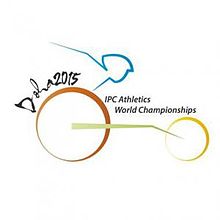Stuart Weir is covering the IPC World Athletics Championships from Doha, Qatar for the Running Network and RunBlogRun. This is the first of his daily doses from Doha. We hope that you enjoy it!
IPC Athletics World Championships
The IPC (Disability) Athletics World Championships gets underway on Thursday when more than 1,300 athletes from over 90 countries contest 212 medal events in Doha’s Suhaim Bin Hamam stadium. That number marks an increase of over 20 per cent on the number of competitors who lined up at the last World Championships in Lyon, France, two years ago. The number of female athletes has also risen by an impressive 39 per cent. The biggest team is the People’s Republic of China with 79, followed by Russia 78 and USA 77.
A record number of broadcasters 22 in total – will broadcast the event round the world and all the action will be live streamed on the IPC’s official YouTube channel, Paralympicsport.tv.
Disability Athletics can be completely unintelligible if you cannot tell an F44 from a T12. F is for field events and T for track. Then there are six categories of disability athletes:
- 11-13: Blind (11) and visually impaired (12, 13) athletes
- 20: Athletes with an intellectual disability
- 31-38: Athletes with cerebral palsy
- 40: Les Autres (others) (including people with dwarfism)
- 42-46: Amputees
- 51-58: Athletes with a spinal cord disability
Thus T12 is a track event for visually impaired athletes, while F44 is a field event for amputees. Amputees rang from 42 to 46 with the lower the number greater the handicap. A leg amputation below the knee is a 44 and above the knee a 42. While the classifications may seem complicated, it is all intended to ensure than athletes are competing against athletes with a similar disability. And just to be clear that event is under the auspices of the International Paralympic Committee, which also runs the Paralympics. It is quite separate from events like the Special Olympics or the Deaflympics.
The word “disability” itself is a bit unsatisfactory. I remember interviewing multiple Paralympic gold medallist and serial city marathon winner, Tatyana McFadden. I used the word “disabled”. She replied to my question: ” I don’t see myself as ‘disabled’; I see myself as very able” and went on to tell me how she regularly lifts weights beside so-called “able-bodied” men – except that she is lifting more than they are!
The elephant in the room is that the event is in Qatar where temperatures are around 35 (95 Fahrenheit). Hosting sports events is very much part of Qatar’s national corporate strategy – the handball world championship next year and World Cup in 2022 for example. The big question is temperature and how athletes from much of the world will cope with competing in temperatures significantly hotter than they are used to. To be fair, the only athlete I have asked about it trains in Arizona – “heat, what heat?” he said.
Will the event live up to expectations? Watch this space for my daily dose from Doha.
Author

Since 2015, Stuart Weir has written for RunBlogRun. He attends about 20 events a year including all most global championships and Diamond Leagues. He enjoys finding the quirky and obscure story.
View all posts





















